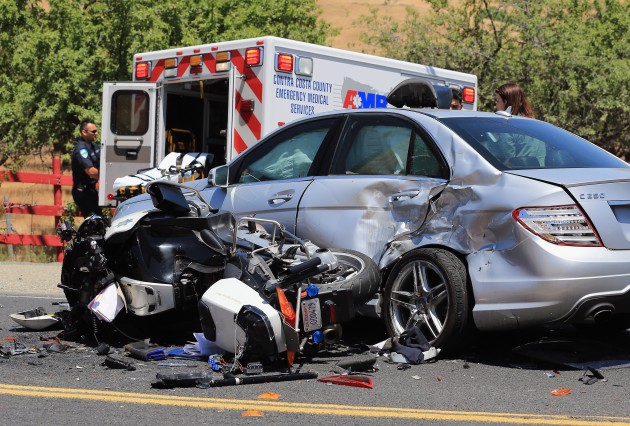Many older motorcycles lacked the safety technology that newer bikes come with. Older bikes usually have tires with poor traction, while newer bikes have greater maneuverability and anti-lock brakes. On these older bikes, it is often safer to slide and fall off the bike rather than to attempt braking suddenly in the event of a sudden accident.
This technique is known as laying down the bike. Unfortunately, laying down a motorcycle in an attempt to avoid an accident almost guarantees that the rider will be injured. Of course, these injuries are incurred in an attempt to prevent a more serious accident. But insurance companies don’t always know that.

Lay Down Bike Accidents
There are only a few instances where laying down a bike is the best option to avoid a catastrophic crash. A car door may open suddenly into your lane. A vehicle may suddenly switch lanes without seeing the motorcycle beside it. For experienced riders, laying down a bike may be the safest option in instances where:
- There is an object in the road that is too big to swerve around: Most people are able to swerve around any sort of obstruction that they encounter on the road, but there are some instances where bikers may need to lay down their bike in order to go under an unavoidable object. This could be something such as a semi-truck that has crashed and is laying sideways across the road.
- You lose control of your bike due to a mechanical issue: If your brakes suddenly fail, or your steering stops responding, and a dangerous situation is imminent, you may need to get off your bike quickly in order to avoid crashing. Laying down your bike in this instance is still dangerous, but you will be closer to the ground as opposed to simply jumping off the bike.
- You risk falling off the side of a hill or cliff if you choose to swerve: When riding on a mountain road, it is possible you may encounter a situation where you either crash into an oncoming vehicle, or risk going through a guardrail and down a steep cliff. In these instances, abandoning and laying down your bike may be your best option.
Injuries From Lay Down Motorcycle Bike Accidents
Lay down motorcycle bike accidents are by no means a way of avoiding injuries. In fact, laying down a bike almost guarantees that the rider will be injured. Some common injuries from laying down a bike may include:
- Broken bones
- Road rash
- Internal bleeding
- Neck injuries
- Spinal cord injuries
- TBI (traumatic brain injury)

Types of Compensation After a Lay Down Bike Accident
If another driver’s negligence caused a sudden emergency, a motorcycle rider will be forced to make a split second decision. Whether you crashed into the car, swerved, or laid down your bike, the negligence of the other driver is what is ultimately responsible for your injuries.
Even if there is no contact between your bike and the vehicle that caused the sudden emergency, you may still have the right to pursue damages for things such as:
- Past and future medical bills
- Lost income
- Pain and suffering
Of course, your insurance company should be responsible for paying these costs. But unfortunately with lay down bike accidents, that’s often far more difficult than you might think.
Motorcycle Insurance and Lay Down Bike Accidents
Insurance companies often don’t recognize that laying down a motorcycle is a valid defense technique for avoiding catastrophic injuries to the rider. Insurance adjusters will often view laying a bike down as a rider playing a part in the overall injuries that were received during the accident, and use that as a justification for not paying out injury claims.
Insurance companies will often place blame on the rider, and try to deny paying medical bills or additional compensation. Having an experienced motorcycle accident attorney in your corner can help demonstrate to the insurance companies that had the rider not laid their bike down, the injuries, and associated medical expenses, would have been far more significant. A skilled lawyer can also help connect you with experts in traffic accident reconstruction, to help prove your case to the insurers.
Lay Down Bike Accident FAQ
- Is it safe to lay down a bike to avoid injury? The simplest answer is; no. Laying down your bike will not help you avoid injuries, and you may become injured because of this maneuver. Laying down a bike can lead to road rash, brain injuries, or neck and back injuries.
- Why is it dangerous to lay down a bike? Laying down a bike is dangerous because once you begin to lay down the bike, you will lose control over it. Bikes can only be controlled, slowed, or steered when they are in an upright position on their tires. Once on its side, a motorcycle will bounce, leaving you at the mercy of random chance.
- How can I prevent a lay-down accident? Proper bike maintenance will go a long way in preventing a laid-down motorcycle bike accident. By checking and replacing your tires, traction will be improved, and keeping your brakes maintained to manufacturer specifications will keep your bike ready to stop instantly.
- How can I prepare for a motorcycle accident? Anyone who rides a motorcycle should be prepared for the possibility of an accident. By practicing swerving and braking suddenly, you prepare yourself for an emergency situation. Set up cones in an empty parking lot and practice swerving around them, slowly at first, and then building up speed.
Other Ways To Avoid an Accident That Do Not Involve Laying Down a Bike
If you believe an accident is imminent, keep your motorcycle upright, giving you control over braking, steering, and swerving if needed. If you lay down your bike and skid, you will not be able to control it and have no options to escape whatever happens.
If a crash seems imminent, try:
- Moving your weight away from the handlebars while applying the brakes. By shifting the bike’s center of gravity and momentum, it can free up the brakes to better do their job.
- Grip the fuel tank firmly with your legs, which can help you stay upright while you are decelerating at a rapid pace.
- Use both your brakes, allowing you to come to a complete stop in a short amount of time and distance. Be prepared, as using both brakes at once will often have a very different feel than using one at a time.
- The key to preventing lay down motorcycle accidents is to ride defensively at all times. Remember that drivers are far too often unaware of motorcyclists, so never assume a motorist sees you.

Swerving as Opposed to Laying Down a Bike
Swerving your motorcycle is often one of the best ways to avoid a crash. Safe swerving means you need to be hyper aware of your surroundings, and that you need to know how to counter-steer and realign yourself after your initial swerve. If you do not realign properly after swerving, you could be thrown to one side and injured.
Even though swerving safely can seem difficult, it is still often a much safer tactic than laying down the bike, as you still have a chance of remaining in control of your bike during a swerve. Laying down a bike will take a few seconds to accomplish, as will swerving, so in the end, both will take about the same amount of time, and braking can help you avoid accident injuries and a bike crash much more effectively.
A Lay Down Motorcycle Bike Accident Lawyer Can Help You Prove Your Case
Riding a motorcycle on a road with larger vehicles is inherently dangerous, and sometimes riders are placed in a position where an accident is unavoidable. Taking an emergency avoidance maneuver like laying down a bike, is often the best course of action. If you had to lay down your bike in order to avoid additional injuries, it is in your best interest to immediately reach out to a motorcycle accident attorney.
The experienced motorcycle accident lawyers at Thistle Law can help you prove to the insurance company that you took the best course of action in laying down your bike, and help you get the compensation you need to pay for your medical bills, lost property, and pain and suffering. Your first consultation with us is always free. Call our team today at 215-525-6824 or reach us online via our contact form.

